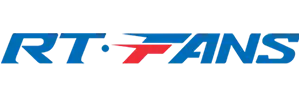Shopping malls consume energy greatly, and cooling systems may consume 30-50 percent of the total use of all operations due to a large area and large populations. As sustainability has become a concern among developers and tenants, the models of greener buildings are provided by schemes like LEED (Leadership in Energy and Environmental Design) and BREEAM ( Building Research Establishment Environmental Assessment Method ). Such certifications are concerned with energy efficiency and indoor air quality (IAQ) and sustainable design, and reward points by utilizing innovative solutions.
The importance of industrial ceiling fans and especially the High-Volume Low-Speed (HVLS) to help the shopping malls meet the energy efficiency, indoor air quality, and sustainability requirements set forth by certifications such as LEED and BREEAM should be noted. By minimizing HVAC loads, improving the air movement, and justifying natural ventilation solutions, HVLS fans will be able to result in the acquisition of essential credits and the subsequent savings of annual expenses by 20-30% of the energy costs that will easily cover the period of 18-24 months. We will dig into the history of these certifications, the function of ceiling fans, real-life examples, comparisons, benefits and ROI.
Background: LEED and BREEAM Standards for Commercial Spaces
LEED and BREEAM are significant green building assessment systems, and they can be applied in a commercial space like a shopping mall. LEED of the U.S. Green Building Council, is a points-based (110 points) system divided, and subdivided, into categories such as Energy and Atmosphere (up to 33 points), Indoor Environmental Quality (up to 16 points), and Sustainable Sites. Minimum Energy Performance (5% higher than the minimum in a new building) and Enhanced Indoor Air Quality Strategies are some of the key credits that are provided in Malls, and the credit is based on higher ventilation and pollutant control.
In the UK, BREEAM scores buildings on a scale of Pass to Outstanding, with credits in the Energy (up to 15%), Health and Wellbeing (up to 15%), and Pollution. The retail buildings also reach out to the points of thermal comfort, low-energy cooling, and refrigerant control of cooling systems. The two systems are based on IAQ ventilation, energy efficiency to minimize carbon footprints, and sustainable design to minimize environmental impact. The malls, which want to win such certifications, will be required to demonstrate beneficial shifts, such as a reduction in the intensity of energy use (EUI) or comfort of occupants, and in this regard, new tools, such as HVLS fans, can be a beneficial source of credits.
How Ceiling Fans Contribute to Green Certifications
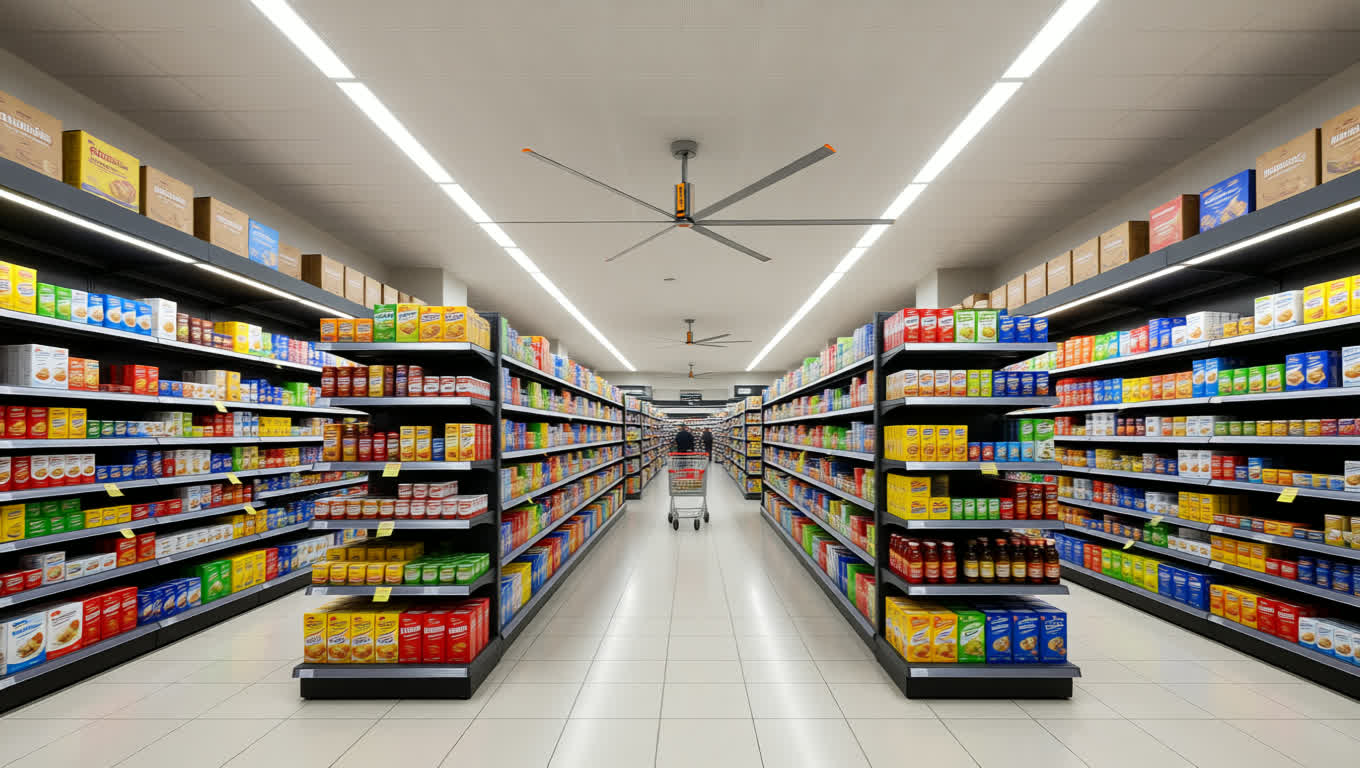
At low speeds, the HVLS ceiling fans (8-24 feet in diameter) can move as much as 400,000 cubic feet per minute of air without consuming much energy. They offer contributions to LEED and BREEAM, which are multifaceted and directly supported by key credits.
Reduced HVAC Load for Energy Efficiency Points
Energy efficiency is the core category of both LEED and BREEAM. HVLS fans conserve HVAC loads (destratification of air) and heat the air at ceilings and in the bottom (cutting heating costs by 20-30 per cent during winter and eliminating the need to raise thermostat settings by 3-5 degrees during summer) by 4 per cent. This helps malls to meet LEED Minimum Energy Performance credit (5% improvement required) and the BREEAM Energy credits by reducing the overall consumption. The optimized energy performance is also enhanced by reduced power consumption (less than 1.5 kW per fan).
Better Air Circulation for Improved Indoor Air Quality Credits
In LEED (up to 16 points), the credits are rewarded by enhanced ventilation and by reduction of pollutants, as well as by the health and well-being section of BREEAM. HVLS fans not only improve air circulation with 15- 20 percent dilution of air pollutants (e.g, VOCs, CO2) but also humidity (10-15 percent) reduction to get rid of moulds. This is the credit of LEED Enhanced Indoor Air Quality Strategies and the ventilation requirements of BREEAM, and therefore, the malls will not be able to lose occupant health points.
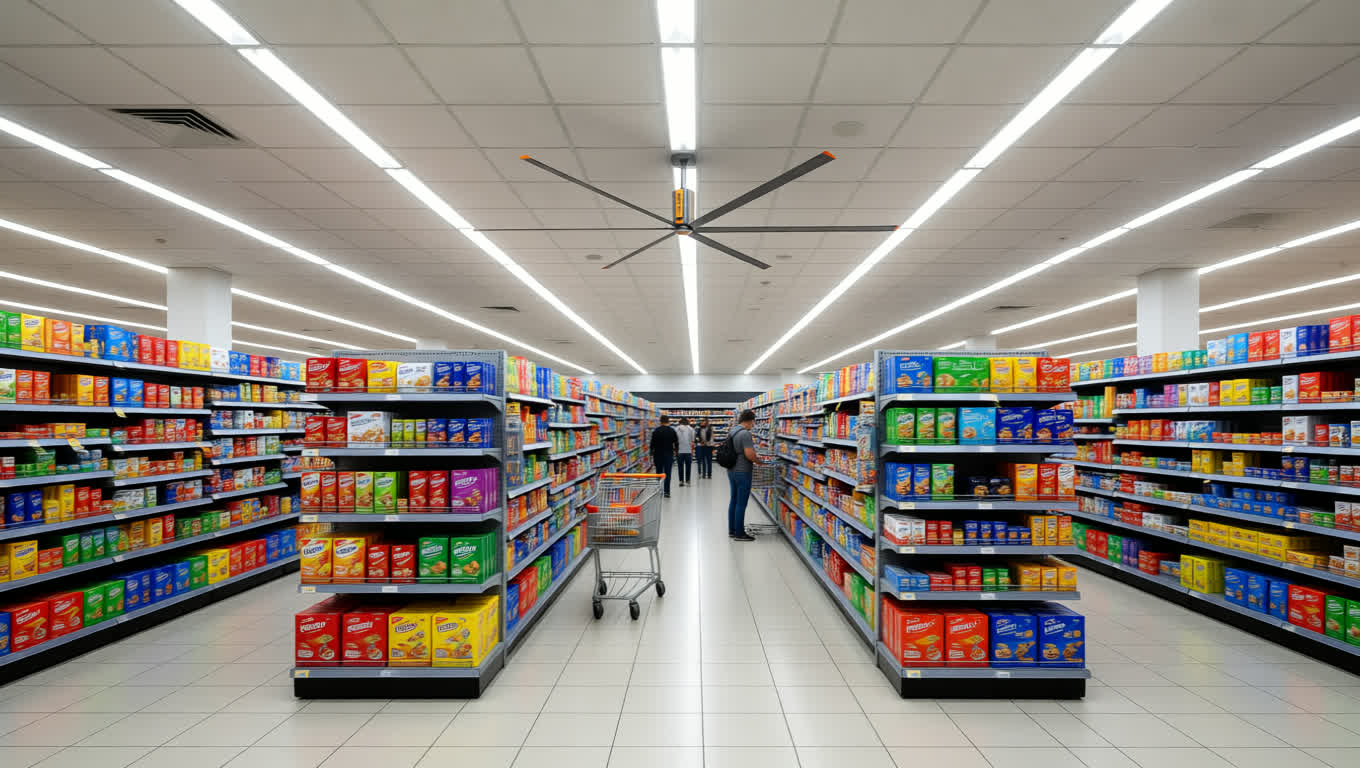
Support for Natural Ventilation Strategies
The two certifications encourage sustainable design through encouraging ventilation using natural or mixed-mode ventilation. This can be contributed to by HVLS fans that promote air movements in the atriums or open areas to reduce the mechanical cooling process. This is helpful. Low-carbon emissions gained through the reduction of refrigerants are recognized as BREEAM pollution credits, and integrated ventilation designs are recognized in the category of Sustainable Sites instead of LEED. The mall activities are not disturbed by the silent operation of the fans (less than 35 dB).
Case Example: How a Mall Achieves LEED Certification with Ceiling Fans
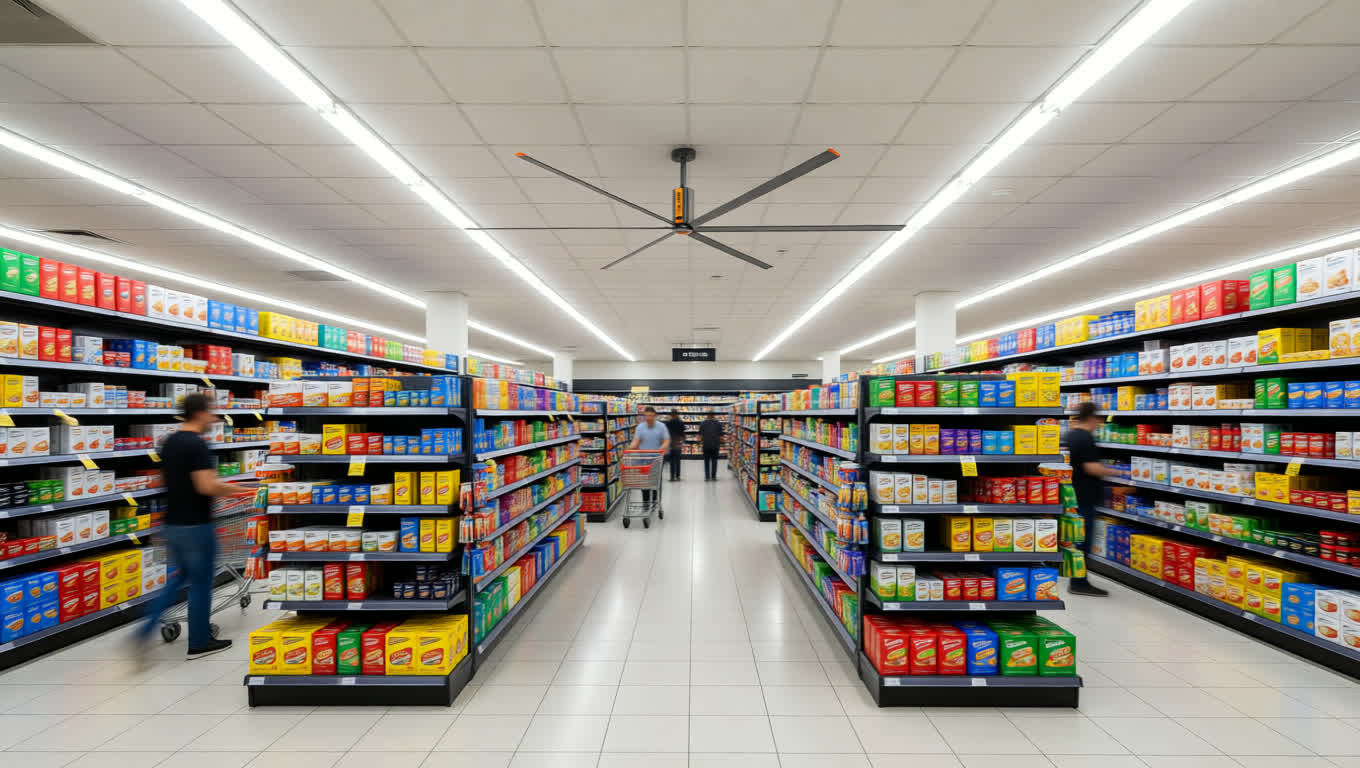
Consider an example of a shopping mall of 200,000 square feet that aims to get LEED certified. The traditional HVAC systems consumed much energy to cool down and did not allow an Energy and Atmosphere credit. The mall used 10 HVLS fans in the atriums and common areas and achieved a 10 percent reduction in HVAC run time, or 10 points in Minimum Energy Performance. The circulation of air with the use of fans also improved the IAQ, and received fans 2-3 points in Indoor Environmental Quality. The mall has been LEED Silver certified, and combined with other green programs like lighting using LEDs, the mall has saved $40,000 in energy bills per annum. This scenario demonstrates that by incorporating ceiling fans in the malls, one can have the same facility certified as LEED.
Comparisons: Ceiling Fans vs Traditional Systems in Sustainability Impact
HVLS fans are also linked to less environmental footprint compared to a conventional HVAC or chiller system. Conventional systems will have refrigerants with high global warming capacity that will result in BREEAM Pollution credits when fans do not require refrigerants. With the help of LEED, fans consume a 1/10 th of the power that it would consume, an equal power cooling system would consume, to facilitate energy optimization. The fans need minimum maintenance (they have to be cleaned once in year), and this waste is not as much as in HVAC which needs to replace the filters on a regular basis. Importantly, the fans are more sustainable as they can be used with 15-20 years as opposed to 10-15 years by chillers.
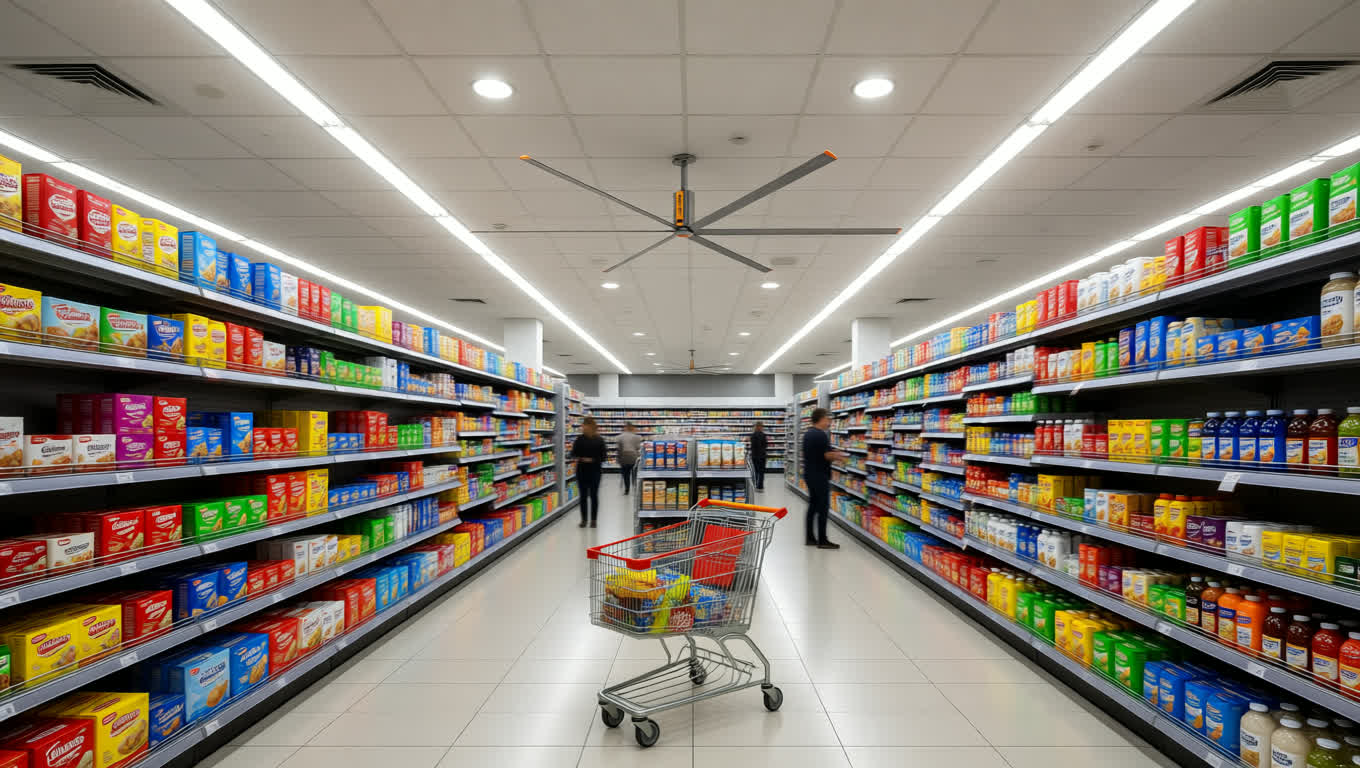
Benefits Beyond Certification
Besides credits, HVLS fans save operating costs of 10,000 to 50,000 a year of energy expenses, improve comfort of shoppers with a 5-7°F wind-chill effect, and increase satisfaction among tenants as a result of maintaining the same temperature in the retail space. Better IAQ reduces the complaints on health issues, which can be used to sustain the mall’s reputation. To the developers, it will indicate that the occupancy rates and property value will rise due to the attraction of eco-friendly tenants through certified malls.
ROI/Sustainability Angle: Green Building Economics

HVLS fan is economical, and its payback period is 18-24 months. A mid-size mall will cost between 20,000 to 60,000 to install; however, the investment is offset by a cost of 20-30 percent of energy savings. As an example, a shopping center with annual cooling costs of 100,000 can save on its annual costs by 20,000 to 30,000. The savings after ROI net will be over 200,000 within 10 years. This economic strategy complies with the concept of green buildings since LEED buildings are valued 10-20 per cent higher. Another point of contact in BREEAM is the costs over the life cycle, which is another factor that encourages the durability and low maintenance of fans, making them a cost-effective and efficient economic choice.
FAQ: Common Questions on Ceiling Fans for Green Certifications
Although not a standalone product, HVLS fans are often useful in achieving LEED Silver or Gold when used in conjunction with other efforts, as they provide credits for energy and IAQ.
Yes, in LEED, they assist in the efficiency and Indoor Environmental Quality credits in energy, and in BREEAM in the Energy and Health, and Wellbeing credits.
HVLS fans reduce decarbonization by cutting energy consumption by 20-30 percent, which is the equivalent of dozens of cars taken off the road each year.
Takes 18-24 months, and saves them $10,000-50,000 annually, so they are a more affordable route to certification, such as LEED or BREEAM.
Conclusion
HVLS industrial ceiling fans could be installed in shopping malls, in an invaluable contribution to energy savings, IAQ, and sustainable design credits in LEED and BREEAM towards green certifications. They offer cheaper prices, comfort, and suitability with economic sustainability, and hence, a strategic decision. The Mall owners and developers ought to install the industrial ceiling fans as part of the green building- it is an economic decision and eco-friendly. RTFANS can offer you a customized HVLS solution in order to be certified to sell in your mall based on our 20+ years of experience. Call us today to find out how our fans can make your project even more sustainable.
